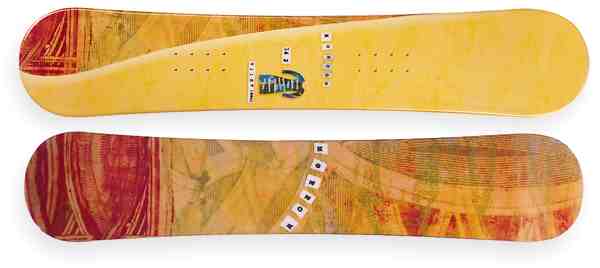What the heck is a
snowboard? |
|||||||||||||
| A snowboard is just a piece of wood!
Ummm . . . maybe back in 1983 you could say that. There's
more to it than that! Impress your friends with your
awesome snowboard technical terms. These will help you
when finding your own board, and to know how to do
repairs and adjustments. Below is a plain, naked (oh my
gosh!) snowboard. Move your mouse over the board below.
When you see a description pop up, you can click it. This
is the top and base to a Morrow snowboard. If your
browser doesn't support image maps, just scroll down.
Top: This is the top image. There's nothing speciall about the top itself. This particular board has a little dress print on it because this is a girl's board. Base: This is the bottom image of the snowboard. Keep your base in good condition. If you get a deep scratch in your base, try to get it filled. It'll save you money later by keeping your base from falling apart. Also makes sure to clean it and wax it often for the best speed...especially on slushy days! Rail Edge: This is the medal "strip" that goes around the edges of your board. Its there to make carving easier and to give your board a better edge. Make sure to get these sharpened about once a season. Binding Holes: This is where you attatch your bindings to the board. You use whats called a plate. Its a round metal disk about the size of a CD. You can put your bidings in almost any position. The above board has 16 holes, four on each row. This varies on each board, some have three across, some are staggered. The first time you buy a board, its definitly best to have someone install the bindings for you. Then you can get a good idea and adjust them from there. Core: This is what makes up the inside of the snowboard. Different companies use different core technologies. You want to look for the lightest core that's still strong and has a good flex. Wood cores are the oldest type. They're usually the heaviest, and boards have advanced light years since these. But hey, if you like 'em, go for it. Leash: This is to save your board from becoming a runaway train. Leashes come in long or short sizes. The long ones attatch to your binding and then rap around your leg in a clasp. The short ones attatch to your binding and then click onto a shoelace or something on your foot. Both are good. I like the long ones because you can make it into a should strap. The short ones are good because they don't get in the way. However, my friend bought a short one and the first day she used it, it fell off in the snow. All snowboard/ski resorts require you have one. If they see you don't have one, they might not even left you on the lift. Stomp Pad: This keeps your foot from flying into your friends face while your getting off the chair lift. This is something you really want. If you like the graphics on your board, try to find a clear stomp pad. While getting off a chair lift, put your back foot on the stomp pad. This will keep your foot from sliding off the board, trust me, it works! If your foot is still slipping, try pushing with your back foot on the binding next to it. Applying pressure usually helps.
The above board is a Morrow Wildflower. The information given is:
SOL: Snowboarding online has a board genie which will help you find a board. It can give you a broad or very specific list of boards based on: your weight, shoe size, type of riding, amount you want to spend and board manufacturers. Very helpful, and has added even more snowboards this year. A must see. Sims: For each of their boards they give you a rider profile, which tells you what kind of riding this board is made for, level of experience and age its designed for, and more. It also gives you a weight range for each size of the board. Performance charachteristics and board featurers are also listed. SnowLink: Snow link will help you get a good idea of what to look for when buying a board for the first (or any) time. It has information for kids, womens and all kinds of boards. Go to the Tips and Pix for everything you need. |
Go to: Home Price Extremes Tricks of the Trade - Brandon, X-treme boarder, explains how to do the newest or advanced tricks in plain English. Hey You! You should be a star! Send me your pictures, stories, web addresses and more and I'll post them in this new section. The form is available here. Visit a snowboard park. If you've ever wanted to know what is in a park, go here. Sign the Indy
Book Snowboard Companies! A listing of snowboarding comapanies, their web address and their mailing address is listed here. Indy Snowboarding, its contents and all original graphics are copyrighted. If you have any questions or comments for the site owner, please send them here. |
